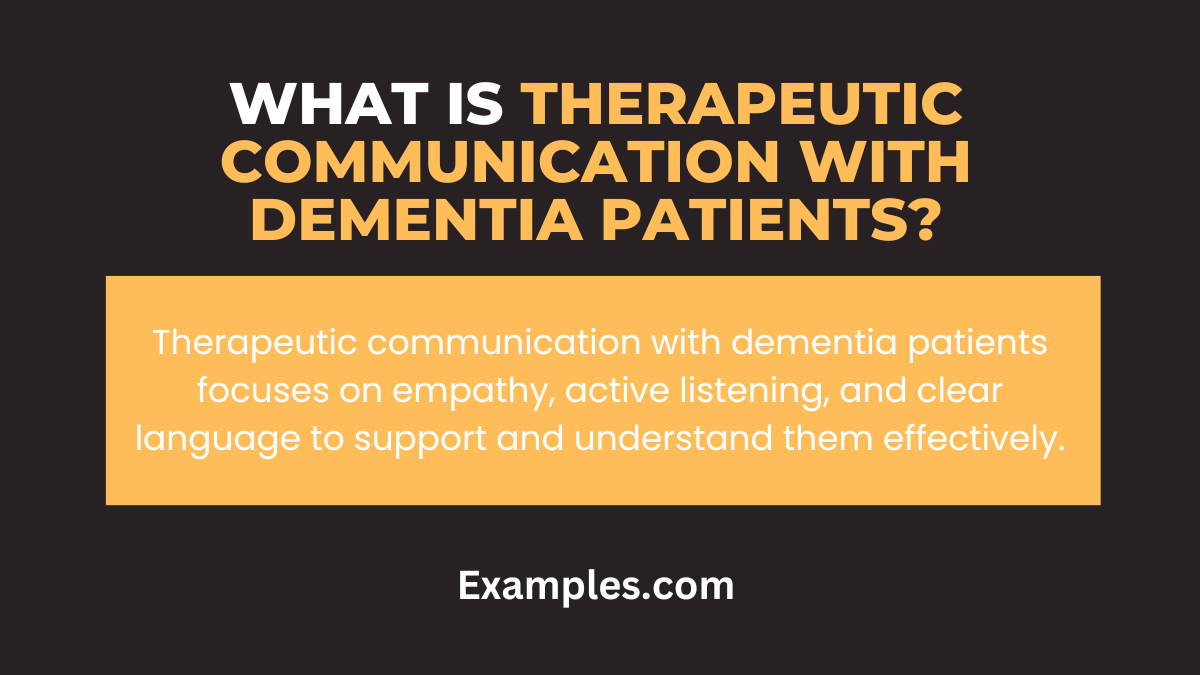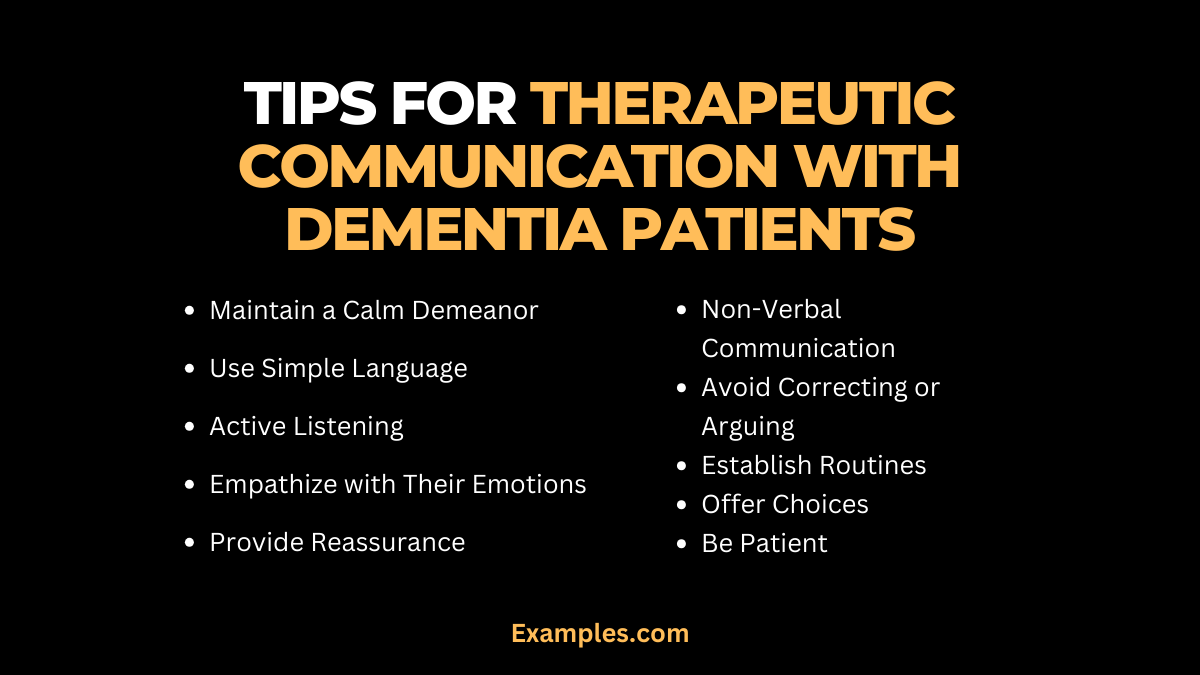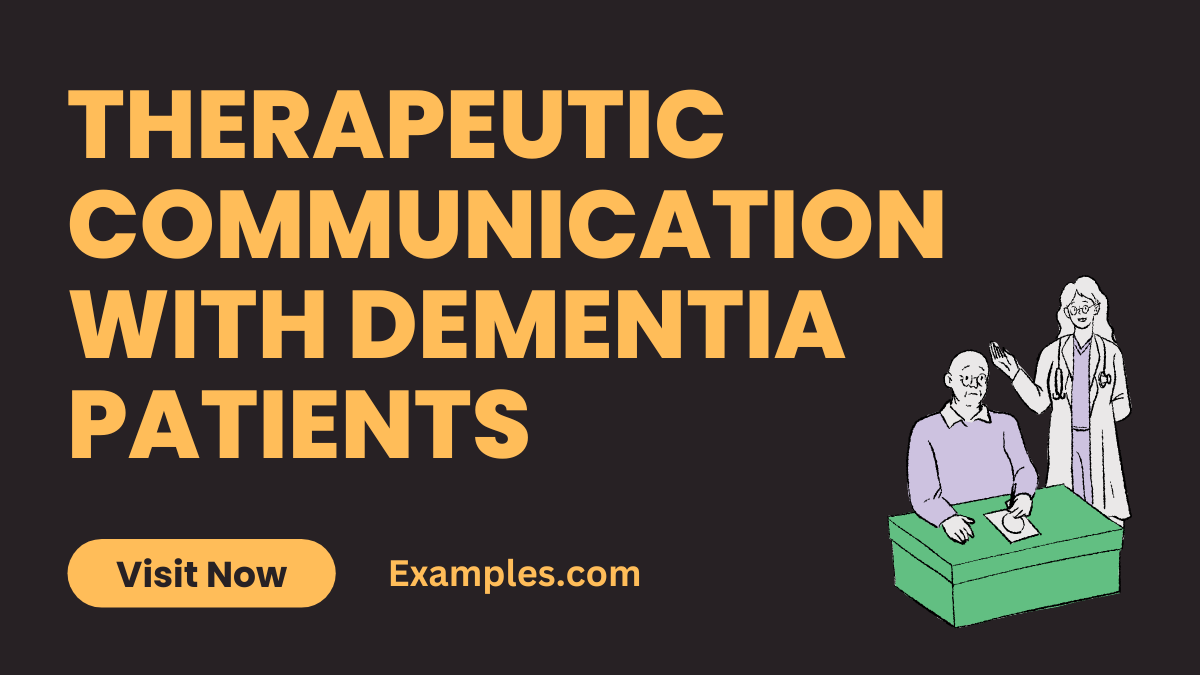Therapeutic Communication with Dementia Patients
Diving into the world of dementia care, mastering the art of therapeutic communication is paramount. In this comprehensive guide, we’ll navigate the nuances of communication with dementia patients, exploring definitions and, most importantly, delving into real-life examples of therapeutic communication that bridge the gap between healthcare professionals and those facing cognitive challenges.
What is Therapeutic Communication with Dementia Patients?

Therapeutic communication with dementia patients entails a compassionate and tailored approach used by healthcare providers to effectively engage with individuals affected by dementia. This method prioritizes empathy, active listening, and clear, concise language to establish rapport and ensure patients feel understood and supported.
15 Therapeutic Communication with Dementia Patients Examples
Discover effective therapeutic communication techniques tailored for dementia patients in this comprehensive guide. We explore 15 unique examples, each accompanied by a brief explanation and real-life scenarios on how to communicate with empathy, respect, and clarity. These examples encompass the essence of therapeutic communication, bridging the gap between healthcare providers and dementia patients.
- Nonverbal Engagement: Hold eye contact and offer a warm smile to convey empathy and understanding.
“Maintaining eye contact and smiling warmly can reassure the patient, making them feel valued.” - Simple Language: Use plain and concise words to explain procedures or instructions.
“Explaining the medication routine in simple terms ensures the patient comprehends their treatment plan.” - Active Listening: Pay close attention to verbal and nonverbal cues, responding with empathy.
“When the patient expresses fear about an upcoming test, acknowledge their feelings and offer reassurance.” - Validation: Acknowledge the patient’s emotions, even if they seem irrational, providing comfort.
“If the patient insists on seeing a deceased loved one, empathetically acknowledge their longing.” - Repetition and Reinforcement: Patiently repeat information and instructions to ensure understanding.
“Repeating the visiting hours helps the patient remember when they can expect their loved ones.”

- Open-Ended Questions: Encourage conversation with questions that invite the patient to share their thoughts.
“Ask, ‘Tell me about your favorite vacation,’ to initiate a meaningful conversation.” - Avoiding Corrections: Refrain from correcting the patient’s beliefs or memories; go along with their reality.
“If the patient believes they are at home, validate their perception to avoid distress.” - Familiar Topics: Engage in discussions about familiar subjects from the patient’s past.
“Talking about their favorite hobby can evoke positive memories and emotions.” - Visual Aids: Use pictures or written notes to support verbal communication.
“Show a picture of the nurse to help the patient remember who is taking care of them.” - Empowering Decision-Making: Involve the patient in decisions related to their care when appropriate.
“Ask the patient if they prefer to take their medication before or after breakfast.” - Redirect and Distract: When the patient becomes agitated or fixated on a distressing topic, gently guide the conversation toward a different, more positive subject.
“If the patient becomes upset about missing an event, redirect their attention by discussing a pleasant memory from their past.”

- Use Mirroring: Reflect the patient’s emotions by matching their tone and body language, fostering a sense of connection.
“If the patient is anxious, mirror their body language and speak softly to provide comfort.” - Offer Choices: Present limited choices to give the patient a sense of control, even in small decisions.
“Ask if they would like tea or coffee, allowing them to make a choice that contributes to their well-being.” - Maintain Consistency: Ensure that routines and caregivers remain consistent whenever possible, reducing confusion.
“Having the same nurse or caregiver for daily tasks helps establish familiarity and comfort.” - Provide Reassurance: Offer gentle reassurance and support during moments of confusion or distress.
“When the patient is disoriented, hold their hand and say, ‘I’m here to help you, and you’re safe.'”
Therapeutic Communication Techniques for Dementia Patients Examples
1. Reminiscence Therapy: Encourage the patient to recall and share pleasant memories from their past to stimulate positive emotions and engagement.
Example: “Ask the patient to reminisce about their childhood vacations, providing an opportunity to connect and evoke happy memories.”
2. Music Therapy: Use familiar music or songs from the patient’s past to trigger memories and emotions, reducing anxiety and agitation.
Example: “Play the patient’s favorite song from their youth, and observe their mood brighten as they hum along.”
3. Art Therapy: Engage the patient in simple art activities like painting or coloring to enhance self-expression and creativity.
Example: “Provide the patient with art supplies and encourage them to paint, allowing them to communicate through their artwork.”
4. Validation Therapy: Validate the patient’s feelings and emotions, even if they seem irrational or disconnected from reality.
Example: “When the patient expresses fear about imaginary threats, reassure them that their feelings are valid and offer comfort.”
5. Montessori-Based Activities: Introduce activities designed for dementia patients, such as puzzles or sorting tasks, to maintain cognitive function and stimulate engagement.
Example: “Offer the patient a puzzle to work on, providing a sense of accomplishment and mental stimulation.”
6. Sensory Stimulation: Use sensory items like textured objects or scents to engage the patient’s senses, promoting relaxation and connection.
Example: “Place scented lavender sachets in the patient’s room to create a calming and pleasant atmosphere.”
How to Therapeutically Communicate with Dementia Patients?
1. Active Listening and Validation: Begin by actively listening to the patient’s words and emotions. Acknowledge their feelings, even if they seem irrational. Use assertive communication to validate their experiences and emotions. For instance, say, “I can see that you’re feeling scared, and it’s okay to feel that way.”
2. Maintain Nonverbal Communication: Nonverbal cues like maintaining eye contact, using a warm smile, and employing a gentle touch can convey empathy and understanding. These gestures enhance the effectiveness of assertive communication.
3. Use Simple and Clear Language: Utilize straightforward and uncomplicated language. Complex sentences or medical jargon can lead to confusion. An assertive communication approach involves expressing ideas clearly and concisely.
4. Avoid Arguing or Correcting: Dementia patients may have distorted memories or beliefs. Rather than arguing or correcting them, use assertive communication to go along with their reality. For example, say, “I understand that you believe you’re at home, and we’re here to keep you safe.”
5. Ask Open-Ended Questions: Encourage conversation by asking open-ended questions that invite the patient to share their thoughts and feelings. Assertive communication involves phrases like, “Tell me about your favorite childhood memory.”
6. Offer Choices: Empower dementia patients by providing choices, even in small decisions. For instance, ask, “Would you like tea or coffee?” This assertive communication approach allows them to maintain a sense of control.
Tips for Therapeutic Communication with Dementia Patients

- Maintain a Calm Demeanor: Approach the patient with a calm and reassuring demeanor. Your demeanor sets the tone for the interaction and can significantly impact the patient’s comfort level.
- Use Simple Language: Employ clear and simple language when conveying information or instructions. Avoid complex or abstract terms that may confuse the patient.
- Active Listening: Practice active listening by paying close attention to both verbal and non-verbal cues. This demonstrates your commitment to understanding their needs and emotions.
- Empathize with Their Emotions: Empathize with the patient’s feelings, even if they seem irrational or disconnected from reality. Acknowledge their emotions to provide comfort and support.
- Provide Reassurance: Offer reassurance during moments of distress or confusion. Let the patient know that you are there to help and that they are safe.
- Non-Verbal Communication: Utilize non-verbal communication techniques, such as a warm smile or gentle touch, to convey empathy and understanding.
- Avoid Correcting or Arguing: Refrain from correcting or arguing with the patient, especially when they express beliefs or memories that differ from reality. Instead, validate their experiences.
- Establish Routines: Create consistent routines whenever possible. Familiarity can help reduce anxiety and provide a sense of security for dementia patients.
- Offer Choices: Provide limited choices to give the patient a sense of control, even in small decisions. This promotes their autonomy and dignity.
- Be Patient: Above all, practice patience. Allow the patient ample time to process information and respond. Rushing can lead to frustration and communication breakdowns.
Mastering therapeutic communication with dementia patients is a vital skill for healthcare professionals and caregivers alike. By employing empathy, patience, and clear communication techniques, we can provide compassionate care that enhances the well-being of individuals facing cognitive challenges. This comprehensive guide, complete with examples and practical tips, empowers us to build trust, create positive interactions, and improve the overall quality of life for dementia patients.



